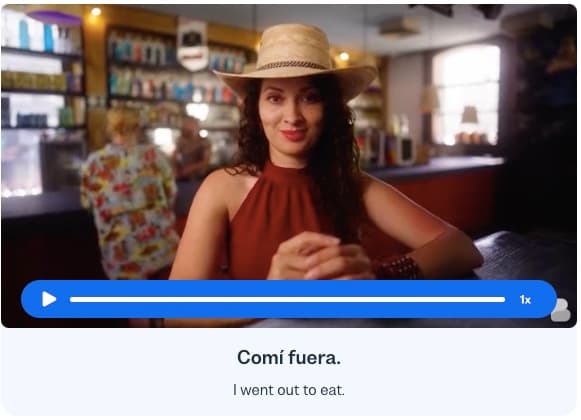I want to learn...
Imagine you want to tell your Spanish-speaking friends about your weekend, but you realize you don’t know which Spanish indicative past tense conjugation to use.
It’s no surprise—there are many different indicative past tense conjugations in Spanish.
But don’t worry, we’ll make sure you have a firm foundation by providing you with an overview of the simple past, imperfect past, present perfect, and past perfect tenses.
Let’s get started!
Indicative past tense conjugations in Spanish
In this article we’ll cover the indicative past tense conjugations in Spanish:
Simple past (pretérito indefinido)
Imperfect past (pretérito imperfecto)
Present perfect (pretérito perfecto)
Past perfect (pretérito pluscuamperfecto)
Each of these tenses is used in certain contexts and for specific reasons.
We’ll start simple, with the simple past.
Spanish simple past tense: Pretérito indefinido
If you’ve studied Spanish for a bit, no doubt you’ve come across the simple past tense. We use this tense for several different situations, including:
Talking about actions in the past that occurred at a specific time.
Narrating a series of events that occurred in the past.
Describing a past action that specifically interrupted an ongoing action.
Talking about actions that had a definite start and finish.
Discussing habits or past repeated actions.
Let’s review some conjugations of the simple past for regular -ar, -ir, and -er verbs.
Simple past conjugation for regular verbs
| Pronoun | -ar verbs | -er verbs | -ir verbs |
|---|---|---|---|
| yo | -é | -í | -í |
| tú | aste | -iste | -iste |
| él/ella/usted | -ó | -ió | -ió |
| nosotros/nosotras | amos | -imos | -imos |
| vosotros/vosotras | -asteis | -isteis | -isteis |
| ellos/ellas/ustedes | -aron | -ieron | -ieron |
Note: Vosotros/vosotras is mainly used in Spain and not in Latin America, where they tend to use ustedes instead.
Here are some examples of sentences using the simple past for regular verbs:
Ella caminó por el parque, compró un helado y regresó a casa. (She walked through the park, bought an ice cream, and returned home.)
Ayer estudié para el examen. (Yesterday, I studied for the exam.)
It is important to remember that irregular verbs do not follow normal conjugation patterns. While we won’t go into the irregular past tense conjugations in this article, here is a list of some common irregular verbs in Spanish:
ser / estar - to be
ir - to go
hacer - to do/make
tener - to have
decir - to say/tell
venir - to come
Now that we’ve reviewed and discussed the uses of the simple past tense, let’s take a look at another indicative past tense form in Spanish: the imperfect past tense.
Spanish imperfect past: Pretérito imperfecto
Like the simple past, the Spanish imperfect past tense is used under certain circumstances.
Here are some situations that may call for the imperfect past:
Describing ongoing or habitual actions in the past.
Setting the background or giving context for events.
Expressing time, age, weather, or emotions.
Describing the past (things, people, habits).
Let’s review some conjugations of the past imperfect for regular-ar,-er-, and-irverbs.
Imperfect past tense conjugation for regular verbs
| Pronoun | -ar verbs | -er verbs | -ir verbs |
|---|---|---|---|
| yo | -aba | -ía | -ía |
| tú | -abas | -ías | -ías |
| él/ella/usted | -aba | -ía | -ía |
| nosotros/nosotras | -ábamos | -íamos | -íamos |
| vosotros/vosotras | -abais | -íais | -íais |
| ellos/ellas/ustedes | -aban | -ían | -ían |
Note: Did you notice that the -er and -ir endings are the same?
Here are some example sentences using the imperfect past for regular verbs:
Los viernes siempre compraba dulces. (On Fridays, I would always buy candy.)
Todos los días aprendíamos nuevas palabras en la clase de español. (Every day, we would learn new words in Spanish class.)
Like with the conjugations for the simple past, these conjugations will differ for many irregular verbs. But we’ll stick with regular verbs for now.
Let’s move on to the “perfect” past tenses in Spanish: the present perfect and the past perfect.
Spanish present perfect: Pretérito perfecto
Despite its name, the present perfect (pretérito perfecto) verb tense is a past tense verb form.
We use it to:
Talk about actions that have happened in the recent past.
Talk about past actions connected with the present moment.
Talk about actions without specifying the time when they occurred.
Take a look at this example sentence using the present perfect tense:
¿Has recibido mi correo electrónico? (Have you received my email?)
The present perfect tense is formed by two verbs, in the above example:
An auxiliary verb has (3rd person singular of the verb to haber, to have), which tells us who did the action.
And the past participle of the main verb recibido (recibir, to receive), which tells us the action they did.
Every present perfect tense is formed using an auxiliary and a main verb.
The auxiliary verb is the verb haber (to have) conjugated in the present tense.
Present tense of haber (to have)
| Pronoun | Conjugation |
|---|---|
| yo | he |
| tú | has |
| él/ella/usted | ha |
| nosotros/nosotras | hemos |
| vosotros/vosotras | habéis |
| ellos/ellas/ustedes | han |
For the main verb, we use the past participle. In the case of regular verbs, the past participle looks like this:
-AR verbs: -ado (for example: hablar (to talk/speak) - hablado)
-IR/ER verbs:-ido (for example: comer (to eat) -comido/recibir (to receive) -recibido)
The sentence structure for the present perfect is straightforward and looks like this:
subject + present of the auxiliary verb haber + past participle of main verb + everything else
Let’s look at some more examples of the present perfect tense:
Ellos ya han preparado la cena esta noche. (They have already cooked dinner tonight.)
Ha hablado en la conferencia sobre su experiencia. (He has spoken at the conference about his experience.)
We won’t cover irregular verbs here.
Now that we’ve learned how to use the present perfect tense, let’s look at the past perfect.
Spanish past perfect: Pretérito pluscuamperfecto
The past perfect (pretérito) tense is used to describe past events that occurred before other past events.
We use the past perfect:
To express an action that had occurred before another past action or event.
To describe past actions that were already completed before a specific point in the past.
To indicate the past condition or state that influenced a subsequent action.
Like the present perfect, we need to use the auxiliary verb haber (to have) for the past perfect.
Instead of using the present tense form of haber (to have), we’ll use it in its imperfect form.
Imperfect tense of haber (to have)
| Pronoun | Conjugation |
|---|---|
| yo | había |
| tú | habías |
| él/ella/usted | había |
| nosotros/nosotras | habíamos |
| vosotros/vosotras | habíais |
| ellos/ellas/ustedes | habían |
Just like with the present perfect tense, we also use the past participle of the main verb and follow the same sentence structure.
Let’s take a look:
-AR verbs:-ado (for example: hablar (to talk/speak) - hablado)
-IR/ER verbs: -ido (for example: comer (to eat) -comido/recibir (to receive) - recibido)
Sentence structure:
subject + imperfect of auxiliary verb haber + past participle of main verb + everything else
Here are some example sentences using the Spanish past perfect tense:
Yo había estudiado antes de llegar a la fiesta. (I had studied before arriving at the party.)
Vosotros habíais aprendido español antes de mudaros a España. (You all had learned Spanish before moving to Spain.)
As before, we won’t cover irregular verbs in this article. Just remember that irregular verbs don’t follow the same conjugation patterns, so it’s important to take the time to learn those as well.
Indicative past tense in Spanish: Recap
We have covered several past tense verb forms here, but don’t worry—the more you practice, the more you’ll get the hang of which tense to use and when.
Here’s a little summary to help you right now:
Simple past (pretérito indefinido): Used to talk about completed actions in the past.
Imperfect past (pretérito imperfecto): Used to describe ongoing or habitual actions in the past or set the scene.
Present perfect (pretérito perfecto): Used to talk about past actions with present relevance or recent events.
Past perfect (pretérito pluscuamperfecto): Used to express actions that had occurred before another past action or point in time.
Knowing and understanding the indicative past tense in Spanish will help you express yourself when talking about situations, habits, or people in the past tense.
We have covered a lot in this article, great job!
Newlanguages


